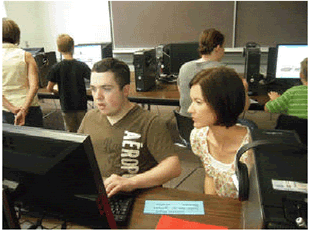News
Sketching skills Collaboration between Google, U. benefits kids with autism spectrum disorder
If you just peek into the computer lab, you can see that the students are using Google SketchUp to build 3-D models of houses or dinosaurs or city parks.
But you have to look deeper to see what else a recent study found they're building with the freeware program: social skills, friendships, self-confidence and better relationships with their siblings. Not to mention skills that may lead to future employment.

The students in the University of Utah iSTAR program range in age from grade school to young adults. About half of them have been challenged by an autism spectrum disorder while others have different issues, from attention deficit to learning disabilities. But when they use the software modeling program, these kids are all-stars — and not in a good-for-someone-with-challenges way, says Tom Wyman, Google manager for business development.
"They are better than most of the world's population with this," he asserts happily of a collaboration that set out to give challenged kids employment skills and ended up changing some lives. "The thing that gets me excited about the project is that SketchUp allows people with autism (and other disorders) to recognize their strengths and use them in a way to contribute to society, be financially independent, build self-esteem and know you're really good at something."
Lonely no more
Nik Charles believes it. His son, Christopher, 12, struggled to make friends because of his autism when he started using the program a couple of years ago. He has those friends now.
Recently, he stood at a podium in front of strangers at a workshop in Florida to explain the technology to others, a fact his father finds astonishing. "I can't do that; I would be too scared," Nik Charles says.
Google SketchUp is used by millions of professionals worldwide to make 3-D models. Architects, teachers, video game designers, theme park artists and others all employ it.
The collaboration between the University of Utah and Google that brought it to these children was serendipitous. A little company in Boulder, Colo., had created the program for architects, before Google acquired it. Google allows employees to use 20 percent of their work time on projects that resonate with them individually and hopefully will help the company, too. For about eight of them, including Wyman, the 20 percent has been Project Spectrum, working with kids on the autism spectrum.
A joyful union
- Cover Story
-
 SketchUp Can Help You Win Interior..
SketchUp Can Help You Win Interior.. -
 Best Laptops for SketchUp
Best Laptops for SketchUp -
 How to Resize Textures and Materials..
How to Resize Textures and Materials.. -
 Discovering SketchUp 2020
Discovering SketchUp 2020 -
 Line Rendering with SketchUp and VRay
Line Rendering with SketchUp and VRay -
 Pushing The Boundary with architectural
Pushing The Boundary with architectural -
 Trimble Visiting Professionals Program
Trimble Visiting Professionals Program -
 Diagonal Tile Planning in SketchUp
Diagonal Tile Planning in SketchUp -
 Highlights of some amazing 3D Printed
Highlights of some amazing 3D Printed -
 Review of a new SketchUp Guide
Review of a new SketchUp Guide
- Sketchup Resources
-
 SKP for iphone/ipad
SKP for iphone/ipad -
 SKP for terrain modeling
SKP for terrain modeling -
 Pool Water In Vray Sketchup
Pool Water In Vray Sketchup -
 Rendering Optimization In Vray Sketchup
Rendering Optimization In Vray Sketchup -
 Background Modification In sketchup
Background Modification In sketchup -
 Grass Making with sketchup fur plugin
Grass Making with sketchup fur plugin -
 Landscape designing in Sketchup
Landscape designing in Sketchup -
 Apply styles with sketchup
Apply styles with sketchup -
 Bedroom Making with sketchup
Bedroom Making with sketchup -
 Review of Rendering Software
Review of Rendering Software -
 Enhancing rendering for 3d modeling
Enhancing rendering for 3d modeling -
 The combination of sketchup
The combination of sketchup -
 Exterior Night Scene rendering with vray
Exterior Night Scene rendering with vray






